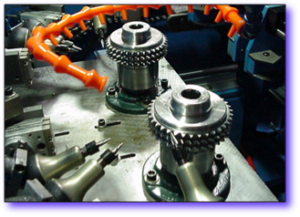Browse Categories

Browse Archives
The Appeal of Wearable Technology in Manufacturing
Wearable technology and its many applications are all around us. Without looking too far, there’s a good chance you’re already familiar with wearables through the technology of an Apple or Samsung Watch, a Garmin model or a Fitbit. Compact, versatile and smart, these fitness trackers multi-task allowing a range of actions from counting steps or minutes spent exercising to answering phone calls or even taking an electrocardiogram on the spot.
Impressive, but when it comes to flexible electronics think of applications that are smaller and potentially even smarter. These incredibly thin electronics contain traces and circuits printed on paper-based flexible substrates.
Produced on foil, paper and even in ink, these electronics retain a high level of conductivity even on curved products and are flexible enough to bend or fold. Such a flexible application, pun intended, offers the potential of roll-able TVs and displays, electronic paper, transparent and smart sensors, not to mention a range of other applications in clothing.
Advantages of Flexible Technologies
Use inexpensive plastics
Low manufacturing costs
Lightweight and bendable
Easily portable
Potentially cheaper
Internet of Things
Over the last five years, tech companies have begun forming collaborations with clothing companies to produce a range of custom apparel products using stretchable electronic inks and flexible substrates. Today it’s easier than ever to find applications of the paper-thin, form-fitting circuits in smart clothing. Companies such as DuPont are manufacturing Intexar, an advanced material. By adding Intexar to clothing like shirts and sports bras, the technology can provide its users with a range of biometric data. Wearing a smart shirt with Intexar has the potential to offer a user or a designated medical provider with information such as heart and breathing rate, form awareness and muscle tension, according to DuPont.
With real-time monitoring and data collection, smart apparel has the potential to not only supply information but also adjust to a range of user needs, like the self-heating jacket created by Ralph Lauren for the Winter Olympics. Use of flexible technologies extends far beyond the world of athletics. Flexible technologies are finding application within the medical, military and first-responder markets. This includes the potential of contact lenses adept at monitoring the glucose levels of a diabetic patient, clothing that can keep first responders safer and jean jackets that offer internet connectivity.
Building Synergies
Akin to the ability to place more and more semiconductors on a chip, flexible technologies show a growing range of possibilities. Imagine a thin layer of film that can regulate the temperature on a home or building or a strip of plastic embedded in a bag that charges the devices inside. Such advances are not only real, they are happening on a small scale now. Research continues as more are discovering the abilities and inherent restrictions of this exciting technology.
This article is brought to you by The Cleveland Deburring Machine Company. CDMC can provide a deburring solution for gears, sprockets, aerospace and defense, automotive deburring, power transmission, powdered metals, fluid power and custom deburring applications.


